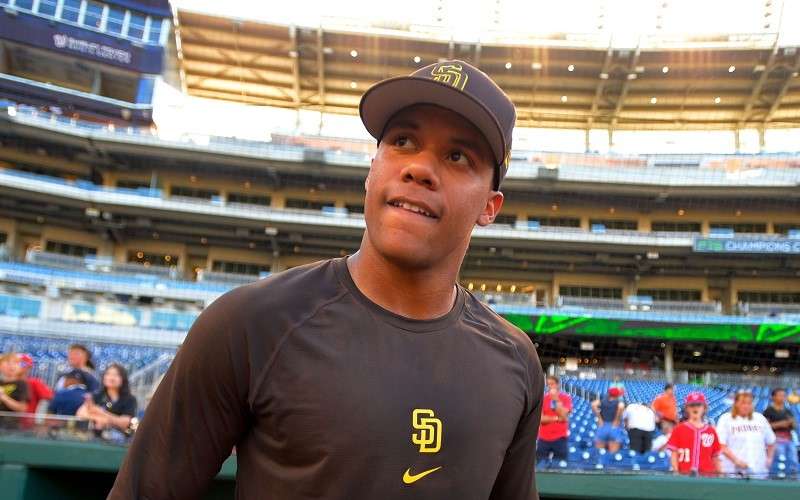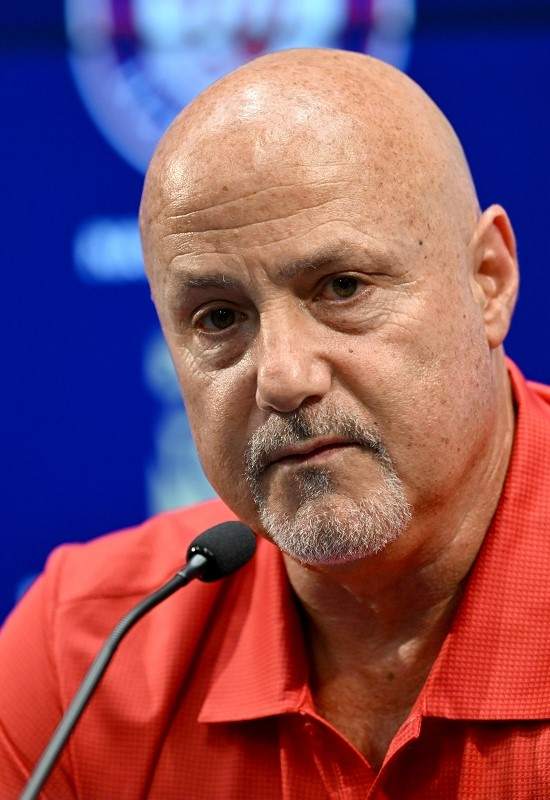How a future without Juan Soto became a reality for the Nats

The Nationals traded Juan Soto to the Padres at the deadline, moving him to San Diego, along with first baseman Josh Bell
11:58 JST, August 15, 2022

Juan Soto is back at Nationals Park this weekend as the Padres visit Washington.
WASHINGTON – Seeing Juan Soto in another uniform, watching him dig in as an opponent at Nationals Park, that was emotional for Dave Martinez. At the start of Friday’s series opener with the San Diego Padres, the image sent Martinez, the Washington Nationals’ manager, deep into his own memory. He remembered Soto helping the Nationals to a title in 2019. He remembered Soto’s huge hits through that World Series run. Going back a bit, he might have recalled a 19-year-old Soto, not yet a major leaguer, impressing with a seasoned plate approach during an exhibition in spring training.
A few months later, Soto was promoted into the Nationals’ lineup and stayed there. At least until the club traded him to the Padres along with first baseman Josh Bell on Aug. 2.
“Whenever I think about it, yeah, it’s really sad,” Martinez said this past Sunday in the visiting manager’s office at Citizens Bank Park. “Ever since the trade, I’ve just felt grateful that I managed Juan and also bummed he’s not here anymore. You go through your head and say to yourself, ‘If this is different . . . if this is different . . . if this is different . . . maybe . . .’ But we got some great young players back for him. Now, all I can do is look at the future.”
Like Martinez, many around the organization have been unpacking the deal in the days since. And in conversations with eight of them – most of which have happened under the condition of anonymity because the people are not authorized to speak publicly – common perspectives emerged: There is frustration that the club reached a point at which trading Soto, a 23-year-old superstar, felt like the best path forward, a product of lapses in player development, misses in the draft, underperformance among once-reliable players, past trades to remain competitive for many years and key injuries, including repeated health issues for pitcher Stephen Strasburg through a seven-year, $245 million contract. But once the deal was finalized, there was also excitement about landing a six-player package of outfielders Robert Hassell III and James Wood, left-handed pitcher MacKenzie Gore, shortstop C.J. Abrams, right-handed pitcher Jarlin Susana and first baseman/designated hitter Luke Voit.
Many in the front office feel these sentiments can coexist. When Soto didn’t take a 15-year, $440 million extension offer in early July, a small group of front office members started to look at teams that could even put together a haul for Soto, let alone part with one. That list included the Padres, Los Angeles Dodgers, St. Louis Cardinals, Tampa Bay Rays, New York Yankees, Seattle Mariners and Toronto Blue Jays, according to multiple people familiar with the process. ESPN reported that the Texas Rangers were in initial discussions, too.
But it took the Padres and San Diego General Manager A.J. Preller to meet the Nationals’ immovable asks. Some teams, such as the Yankees, didn’t have prospects Washington coveted, according to two people with knowledge of the club’s thinking. Other teams, such as the Cardinals, were not as aggressive as publicly characterized, according to three people.

Washington General Manager Mike Rizzo is guiding the Nationals through a rebuild.
Then on Aug. 1, Preller acquired all-star reliever Josh Hader from the Milwaukee Brewers and didn’t move any prospects the Nationals wanted. Deep into that night, Preller and Mike Rizzo, Washington’s general manager, went back and forth. Joining Rizzo in the Nationals’ war room was Mike DeBartolo, assistant general manager in charge of baseball operations; Mark Scialabba, the AGM who coordinated the in-person scouting of possible acquisitions; Ted Towne, the team’s chief financial officer; De Jon Watson, director of player development; and James Badas, assistant director of baseball operations. Max Ehrman, a high-ranking member of the analytics department, also joined them at points.
Throughout the weeks-long process, Rizzo kept saying he would hold onto Soto if the deal wasn’t right, according to multiple people familiar with the situation. Trading him over the winter was another avenue. So was seeing if potential new owners might be able to keep Soto in D.C. for the bulk of his career, though multiple people said the club never solicited input from prospective buyers.
By 3 a.m. Eastern, with about 15 hours until the trade deadline, the two sides had the framework for a deal.
“From the beginning, Preller seemed like the GM who was going to make a big move like this,” said one person with the Nationals. “But once the Hader deal happened, I think there was a sense that they were going all in and he wasn’t going to let the deadline pass without getting Juan Soto. In that way, it was like a perfect storm.”
The next morning, Soto received a call from his agent, Scott Boras, with the news. They had much spent of the past year discussing the Nationals’ offers and Soto’s potential worth on the open market. In the months before the coronavirus pandemic began, the team offered extensions worth $110 million and $180 million, according to three people with knowledge of the matter. ESPN previously reported those efforts. Then in the last nine months, they dangled a 13-year, $350 million offer; a contract with a total value of $415 million this spring; and the final $440 million offer in July.
According to multiple people with Washington, there was hope that, at the very least, $440 million would kick-start discussions with Soto and his camp. But when that didn’t happen, when Boras never countered, Rizzo’s willingness to field trade offers intensified.
During the all-star break, Boras told the New York Post the offer was not in the “range of consideration.” The average annual value of $29.3 million was well below that Soto and Boras seek. That only confirmed the Nationals’ doubts about signing him to a long-term extension before he could reach free agency after the 2024 season. And if they couldn’t, they viewed this deadline as a chance to move Soto, one of the best to play for the Nationals, to restock a thin farm system and potentially accelerate a rebuild that has them angling toward a third consecutive last-place finish.
That and Preller’s aggressiveness was how Soto wound up in the opposite dugout Friday night.
“It was pretty tough to go through it.” Soto said of leaving Washington. “But at the end of the day, I really understand that it’s a business and you got to do the best for yourself. They just did the best for them. And I’m happy with them, whatever, no hard feelings or anything like that.”





